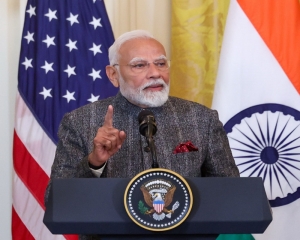Ek Bamushkil Diya Jalata hoon
Author : Deepak Kashyap
Publisher : OPUS, Rs 390
Ek Bamushkil Diya Jalata Hoon by bureaucrat-author, Deepak Kashyap is beautifully crafted and unravels layers of intense emotions. Deepak Kumar Jha reviews the book
An Urdu poet of remarkable depth and vision, Deepak Kashyap has been quick to clarify that ghazals are his first love — right from adolescence when he was a student of English at Patna University. The 91 page pocket-sized Ek Bamushkil Diya Jalata hoon (EBDJH) has 47 Nazms and ghazals in all.
Going through them one by one or even flipping through some of the pages randomly, it is hard to miss the tender mix of emotions — of pathos, love, yearning, reminiscence, hope, despair, longing, frenzy and disenchantment. Above all, is a deep undercurrent of spiritual quest coursing through his entire poetry. It holds in it values and vicissitudes of life’s journey, more than the fulfilments of its goals, if at all they exist.
Kashyap has consciously kept the language of his ghazals simple avoiding use of difficult and heavy Urdu, and instead, weaving his magic in simple “Hindustani” that is much closer to the language that the Hindi heartland speaks. When he does use a few difficult Urdu words of Persian/ Arabic origin — albeit reluctantly — the verses leave behind an enormous impact. The book takes care that the effect is not lost even on those unfamiliar with Urdu diction, through footnotes that carry their English and Hindi translations.
The simplicity of language doesn’t stop him though, from imbuing his poetry with a touch of class that one would normally associate with modern masters rather than with first-timers.
The ghazals — practically all of them — are superbly crafted, delicately nuanced to unravel layers of meaning upon reading over and over again.
The depth of meaning and repertoire of emotions doesn’t come though at the expense of their musical appeal. Most of the ghazals are so rich in alliteration and musical resonance that they would be run-away success if turned into musical compositions of matching caliber.
A couple of gems from the book: Bhoolein Jo Rasmo Raah Toh Is Ahtayaat Se, Humko Malal Apko Sharmindahi Na Ho; (If estrangement is the way forward, let it come ever so gently. For, when we look back, I shouldn’t be rueful and you shouldn’t be ashamed)
And then: Ahista Ahista Chalein Us Maqaam Ko, Sarmaya Jahan Gham Ka Khushi Lootati Na Ho (Slowly, we must gather ourselves to reach those pinnacles. Where joys don’t plunder the wealth of sadness)
Kashyap shares that he was tempted to use the word “Saman” instead of “Sarmaya” for the sake of simplicity, but in the end settled for the latter, since “Sarmaya has a deeper resonance not quite captured by Saman”.
The book holds the readers interest throughout and each page shines with beautiful and reminiscent imagery. The author seems to make a deliberate attempt not to put his words to deflect the subject with titles or sub titles or chapters. Page 91, however, is in continuity with small stanzas.
It may seem odd to talk about the Preface of the book — the “Prastavana”— at the end, and not at the beginning, of the review. This is on purpose though. For this preface carries a beauty of its own.
Written in even simpler language than the poetry that follows, more Hindi than Urdu in fact, it reads less like a dry introduction of the main section, and more as an endearing anecdotal account of how the poet in Kashyap struggled through the early formative years when he was trying to measure up as a budding civil servant with ever increasing official burdens, and was yet not willing to give up on his latent creative faculties.
Overall, it is a remarkable account of a highly unusual, yet enticing journey of a young man from being a bureaucrat to turning a serious yoga practitioner, then an English author of repute, and finally finding his true calling as an Urdu poet of excellence by letting his poetry absorb and exude all the essence and charm of understated spirituality.
In this age of frenzy and living in the fast lane, this book of ghazals may seem to be an oddity at the first glance. But once you start reading the first few lines, it simply sweeps you off your feet.
His earlier title in English “Yoga: Anatomy and the Journey Within” has already gone into several editions, winning Indian Defence Ministry’s recognition and international acclaim in the process. The author also possesses deep knowledge of Ayurveda.
His inclination towards engaging himself and simultaneously others into reading and leisure can be measured in the very thought of conceptualising the launch and then success of Indian Railway’s first ever on-board bilingual monthly magazine “Rail Bandhu” published for several years by The Pioneer newspaper group.



























